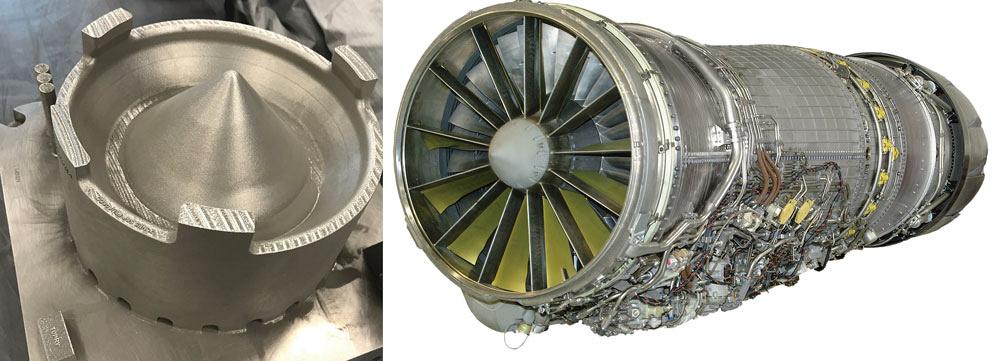- FMA
- The Fabricator
- FABTECH
- Canadian Metalworking
GE receives airworthiness qualification for first metal 3D-printed, critical jet engine part
First engine component produced and designed by additive manufacturing
- October 18, 2021
- Article
- Metalworking

This additively manufactured, cobalt-chrome sump cover (left) for the F110 engine (right) was produced on a GE Additive Concept Laser M2 machine at the GE Additive Technology Center in Cincinnati, as part of a collaboration with the U.S. Air Force’s Rapid Sustainment Office. GE Additive
GE Aviation has received Engineering Change Proposal (ECP) approval from the U.S. Air Force (USAF) for an F110 additively manufactured sump cover. The latest milestone in the USAF and GE’s pathfinder Pacer Edge program, this is the first engine component designed for and produced by metal additive manufacturing to be qualified by any U.S. Department of Defense entity.
“Much like the GE90 T25 sensor that was an FAA certification pathfinder for metal additive manufacturing for GE Aviation in commercial aerospace, the F110 sump cover sets a solid foundation for many more additively manufactured component qualifications with GE’s military customers,” said Matt Szolwinski, chief engineer and leader of GE’s Large Military Engineering team.
The airworthiness qualification of the sump cover brings Pacer Edge Phase 1a of the pathfinder to its conclusion.
Close collaboration and knowledge sharing have enhanced the USAF’s spiral development approach of continuously identifying, reverse engineering, and developing technical data packages for increasingly complex and larger parts suitable for metal additive manufacturing.
“USAF’s strong vision for additive as part of its wider sustainment and readiness strategy has allowed our combined team to progress at speed. We continue to share our learnings and have developed an efficient, structured way of working—especially for developing qualification processes and expediting design iterations. This lean, operational efficiency is already driving results and now sets us up for the next phases of the program, including looking at complex and large format, load-carrying structures,” said Szolwinski.
Phase 1b is already underway and focuses on an out-of-production sump cover housing on the TF34 engine, which has been in service more than 40 years.
“We’re thrilled to be on this journey with USAF. Additive journeys are great, but even better when you have a good map and experienced guides. We started with a relatively easy part, but the spiral development model is coming into its own. It provides focus for the team and our experts help navigate and problem solve along the way,” said Lisa Coroa-Bockley, general manager for GE’s Advanced Materials Solutions.
A digital thread also runs through the pathfinder. GE experts focused on digital twinning, maintenance-based predictive analytics and part lifecycle management expertise have been able to complement the USAF’s digital engineering strategy and in-house knowledge.
“Human interaction and collaboration both add immense value to our work, but digital is the enabler. Additive is a powerful digital technology that spans the entire process, from design and modelling, to in-situ monitoring through to inspection and final level assurances,” added Coroa-Bockley. “Adding digital twinning and predictive analytics on top brings new horizons into view, such as systems management, diagnostics and repair of in-field systems.”
subscribe now


Keep up to date with the latest news, events, and technology for all things metal from our pair of monthly magazines written specifically for Canadian manufacturers!
Start Your Free Subscription- Industry Events
MME Saskatoon
- May 28, 2024
- Saskatoon, SK Canada
CME's Health & Safety Symposium for Manufacturers
- May 29, 2024
- Mississauga, ON Canada
DiPaolo Machine Tools Open House 2024
- June 4 - 5, 2024
- Mississauga, ON Canada
FABTECH Canada
- June 11 - 13, 2024
- Toronto, ON Canada
Zoller Open House & Technology Days 2024
- June 12 - 13, 2024
- Ann Arbor, MI




















